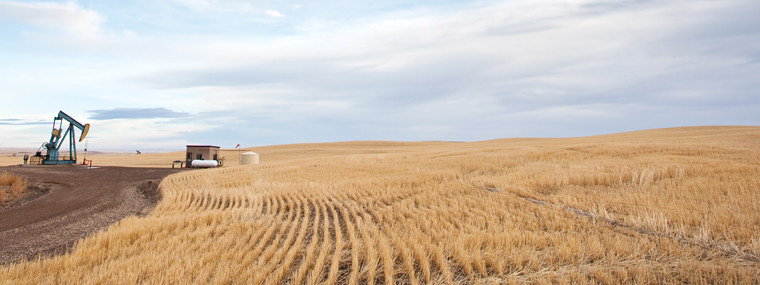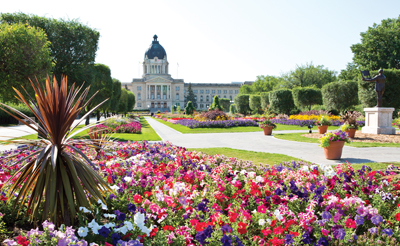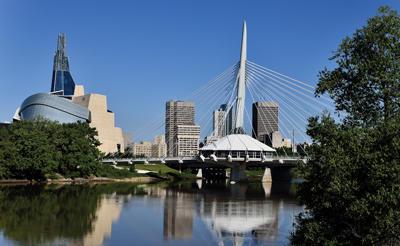
Regional Profile: The Canadian Prairies
Insight on Alberta, Saskatchewan, and Manitoba
By Terri Perrin / Published March 2019

Editor’s Note: This is the second in a series exploring the pressure cleaning industry in Canada, focusing on the provinces of Alberta, Saskatchewan, and Manitoba.
The Landscape
This region of Canada may be known as “The Prairies,” but if you think you would find nothing here but endless grasslands, think again! The vast tract of land that includes the provinces of Alberta (AB), Saskatchewan (SK), and Manitoba (MB) begins at the eastern border of British Columbia (BC), where the majestic Rocky Mountains end; from there it measures almost 1,100 miles east to Ontario and about 750 miles from north to south.

Photo of Jasper National Park. Courtesy of Mark Caovette.
Flatness is by far the defining adjective of the southern parts of these three provinces, though the Prairies’ mostly underpopulated northern regions are densely forested and hilly. The dark soil that blankets these three provinces is the best in Canada, representing nearly 90 percent of the country’s arable farmland with vast fields of wheat, barley, canola, and world-famous Alberta beef.
The natural resources that lie beneath that rich soil also generate a livelihood for many, with forestry, mining, and oil and gas all being primary economic drivers. Towering windmills often dot the southern landscape, as renewable energy is a growing industry here as well.
The Athabasca oil sands (or tar sands), which are large deposits of extremely heavy crude oil (bitumen), roughly centered on the boomtown of Fort McMurray in northeastern Alberta, are what seem to make global news in recent years due to concerns about their environmental impact. That, along with Canada’s on again, off again efforts to build the TransCanada Pipeline—but that’s a whole other story!
Tying all of this together is a thriving transportation sector that provides excellent opportunities for power washing service providers offering fleet washing for trucking and railcar companies.
Alberta
Named after Queen Victoria’s fourth daughter, Princess Louise Caroline Alberta, The Canada Guide (www.thecanadaguide.com /places/the-prairies) offers this colorful explanation about the Province of Alberta: “The country’s energy powerhouse, Alberta has exploited its vast natural resources to become the richest per-capita province in Canada—with a generous self-image to boot. Today, Alberta is known for being a sort of ‘Canadian Texas’ due to its vast oil fields, cowboy culture, and long tradition of political conservatism.
“Owing to the region’s comparatively dry, grassy landscape, Alberta’s early homesteaders found their land better suited for cattle ranching than farming and founded a thriving Alberta beef industry that continues to this day. Its poor farmland scaring settlers to the lusher terrains of neighboring Saskatchewan and Manitoba, Alberta languished in its first few decades of provincehood, but then in 1947 oil was discovered in the city of Leduc, and the place was never quite the same.”
This region is equal in geographic size to about 20 percent of the entire continental USA (excluding Alaska), yet the total population is only about 6.45 million. The population density varies significantly in each of the provinces, with AB home to approximately 4.1 million people, SK to 1.1 million, and MB to 1.28 million. It is important to note that the population is more evenly distributed than any other region in Canada. Towns and cities are spread all over the interior of the three provinces rather than huddled along the U.S. border, as is common in the rest of the country.
The Prairies and the Pressure Washing Industry
With only a few major population centers spread across over a thousand linear miles along the TransCanada Highway, most power washing-
related manufacturing and distribution centers are based in Calgary or Edmonton, AB, with branch offices in the smaller centers.
Magikist is located in Winnipeg, MB. The company was incorporated in 1967 and started by importing high-pressure pumps from Japan. Over the years, they have expanded to include equipment in car washing, industrial cleaning, and agricultural cleaning.
“We have a staff of 20 in our 20,000-square-foot facility,” explains Micah Cohen. “Major components that we manufacture include multi-bay
car wash systems, pressure washers, hot water heaters, vacuums, and cleaning compounds. In addition, we manufacture a number of electronic items such as our iCoin and SecureCoin coin acceptors, timers, and other specialty electronics. Some of our products extend outside our typical product areas, such as our Pulse Jet Deicer for thawing frozen water service lines. Our products are sold and distributed throughout Canada and into the United States, with sales also reaching Europe, Mexico, and parts of South America.”
Saskatchewan
The name “Saskatchewan” comes from the Cree language and the word Kisiskatchewani Sipi, meaning ‘swiftly flowing river.’ (And the 340-mile long Saskatchewan River is just that!) The Canada Guide refers to Saskatchewan as the most easily stereotyped of the Prairie provinces, including having “the flattest land and the biggest farms.” The Guide notes, “The most easily stereotyped of the Prairie provinces, Saskatchewan is said to contain the most intense version of everything the region is known for: the flattest land, the biggest farms, and the dullest people. Though the last point can certainly be debated, the other two are indisputable: Saskatchewan is entirely mountain-free, and its vast acres of farmland comprise nearly 50 percent of the country’s total.”
“The province’s one million residents remain fairly spread out, and Saskatchewan’s two biggest cities, Regina and Saskatoon, house less than 40 percent of the provincial population. The province’s famously easygoing, small-town culture of tractors, trailers, and truck stops has been celebrated in everything from sitcoms to folk songs.”
Mark Caouette, manager of Alberta operations for Easy Kleen Pressure Systems Ltd., explains that Easy Kleen has more than 100 employees located in five different locations across Canada, including one in Edmonton, AB. The company manufactures and distributes a wide range of both hot and cold water, gas and electric systems for a variety of commercial and industrial uses, as well as specialty systems ranging from truck-mounted units to full car washes.
He says that in the past, the Edmonton office was more focused on providing equipment and services to the petroleum industry, forestry, and farming operations throughout the western provinces. That all changed when the oil industry experienced a market crash in 2014. The energy industry in AB and SK is still struggling to recover, which has put some real pressure on all pressure washing manufacturers and service providers to become more creative in identifying new opportunities.
“I think the Prairies region is tightening up in all aspects of the pressure washing industry as a result of that market crash,” says Caouette. “We continue to research areas where we can broaden our focus. Boat washing is one example of an area of growth, as environmental regulations are tightening concerning boats coming and going from the various lakes. As environmental regulations change, we have had to adapt, and this has opened new opportunities for our industry.”
Caouette explains that their Edmonton location is ideal, offering relatively easy access to all of western Canada. “AB and SK may be landlocked provinces, but Edmonton has an international airport and is on the major highway transportation route that is considered to be the gateway to the north. We’ve sent our products to Alaska and the Northwest Territories, shipping first by truck and then flying products into diamond mines [and other sites] in remote areas.”
When asked what might surprise Cleaner Times’ readers, Caouette was quick to respond. “With all of the misinformation and negative press out there relating to energy production in Canada, specifically in Alberta, I think readers would be surprised to know that we are a net zero pollution emitter, even though we have a big [energy] industry.”
The Financial Post backs his claim, reporting on “the most recent report (2014) of the Global Carbon Project, which states that global human-induced CO2 emissions [in Canada] were 36 billion tonnes. Of that, 36 percent stayed in the atmosphere, 27 percent was absorbed by water, and 37 percent was absorbed by land. That’s right—absorbed by land! Not all CO2 emitted by people stays in the atmosphere. Much of it returns to the earth, mainly through the carbon absorption and sequestration power of plants, soil, and trees.”
Ben Kronewitt is the sales coordinator at Hotsy Water Blast Manufacturing in Edmonton. Established in 1973, this is one of the original branches in the Hotsy network, which carries more than 100 models of hot and cold Hotsy pressure washers, automatic parts washers, insulated caustic dip tanks, water treatment systems, and more. (If they don’t stock it, they build it!)
Manitoba
The name ‘Manitoba’ is believed to have originated from the Cree term “Man-into-wahpaow,” meaning “the narrows of the Great Spirit,” which describes Lake Manitoba and how it narrows significantly at the center. Because it is located in the very center of the country, Manitoba is fondly referred to as “the heart of Canada,” and the provincial slogan is “Where Canada’s heart beats.”
Geographically, Manitoba is a mix of northern forests and southern grasslands and contains three of the country’s biggest lakes. The vast majority of Manitobans live in or around the capital city of Winnipeg.
The Canada Guide says: “Manitobans boast of being hearty survivors of some of the harshest weather in Canada (floods and tornadoes are not uncommon), but also take pride in the natural beauty and varied wildlife of their region, which includes beavers, bears, caribou, wolves, and buffalo. In contrast to Alberta and Saskatchewan, Manitoba lacks an easily caricatured identity and has had far less cultural, political, and economic impact on Canada at large. In many ways, the defining theme of Manitoba may simply be its mellow diversity — of land, nature, politics, and people.”
Kronewitt says that Cleaner Times readers might be surprised to learn that the Edmonton branch is the largest Hotsy Water Blast distributor in North America. In addition to the manufacturing operations in Edmonton, they have seven other locations in the Prairies, including Calgary, Lethbridge, Red Deer, and Grande Prairie, AB; Langley, BC; Estevan and Regina, SK; plus two locations in North Dakota. The SK operations are a recent addition to the Hotsy network. They took over the region and added the Regina branch in 2018 and hope to add an office in the city of Saskatoon in the next 18 months.
A large percentage of their business is with the petroleum industry in AB, southern SK, and North Dakota, while agriculture is prominent in all three prairie provinces. Kronewitt credits an excellent transportation system and thriving industries as contributors to the success of the Hotsy brand.
The sprawling 60,000-square-feet Edmonton location is the hub of all Hotsy operations, serving customers in BC, AB, and SK as well as Canada’s far north regions of the Northwest Territories, the Yukon, and Nunavut. They do not service MB because they do not have distribution rights in that area. And, as with other manufacturers and suppliers in western Canada, many find that MB is better served by Ontario operations due to proximity.
“We are also a manufacturer and distributor of the Water Blast and Storm King brand of custom-built top-loading and front-loading automatic parts washers and insulated caustic dip tanks to suit a wide variety of in-dustrial cleaning needs,” adds Kronewitt, “These products complement, rather than compete with, the Hotsy brand. We often build the units in sea cans and then ship them to remote loca-
tions. We have one special order en route to Baffin Island, Nunavut, right now. We’ll build anything for pretty much any industry: oil and gas, fire suppression units for rig sites, skid units, and more.”
Industry Challenges
The drawback to doing business here? “The Prairies are different than other regions in Canada and the USA in that the population is spread out over such a vast geographic area, and it can be challenging to provide service to remote areas,” says Kronewitt.
Caouette agrees. “It’s a great job, but with such long distances between cities and to our customers at the various oilfield services, mines, and such, there is a lot of driving involved. It can be tough, especially in the winter months. But hey, I’m driving through the mountains of Jasper National Park right now. The sun’s shining, reflecting off the white snow. It’s a beautiful sight! Do you want a picture?” he adds with a laugh.
From a human resources standpoint, Caouette states that there are not a lot of people who know about pumps in particular and the pressure cleaning industry overall. “You have to pay well to attract and keep qualified people, but in general, I would have to say that the Prairies region is a great place to do business.”
Cohen reports that Magikist has always had very good employee retention. Some employees have been with them for more than 40 years.
“We have a stable workforce that has a no-layoff policy,” says Cohen. “I personally would not say there have been challenges with operating in
a prairie province. We are centrally located, which is a benefit, and have enough resources locally that are available should the need arise.”
The weather is also a major factor on the Prairies. Although the summers are spectacular, winters can be long and cold. Snow comes to the northern regions as early as September and could last until May. In the south, winters are typically October through March, with deep snow and bitterly cold temperatures making exterior power washing impossible. Southern and central AB, however, benefit from a weather phenomenon called a “Chinook,” which is a native word meaning “snow eater.” Periodically throughout the winter months, warm, dry, gusty, westerly Chinook winds sweep the region, causing temperature changes from well below zero to balmy spring-like temperatures in a matter of a few hours. The resulting massive snowmelt and sloppy road conditions result in significant opportunities for power washers that provide fleet washing services!
Cohen agrees, adding, “The Prairie Region differs from other parts of Canada in car wash equipment primarily because of climate. Winter temperatures in the prairies are colder than Southern Ontario, Quebec, and the Maritimes, which affects the design and operation of the equipment. The simplest example is that prairie car washes will typically be a building with one entrance and exit door for the entire car wash. In other areas of the country, the car washes will be designed with entry and exit doors for each bay, if the bays even have doors.”
“Western Canada is a good place to live, no question about that,” declares Kronewitt. “Up until the recent economic crash, the Alberta economy led the country in growth, which makes for good wages. But as with anything, your biggest strength can also be your biggest weakness. We have had a 30 percent increase in population in the last 10 years, and it is not easy to have the supportive infrastructure to accommodate this level of growth when the rest of Canada is about 10 percent. I would have to say that’s the biggest challenge of doing business here.”








